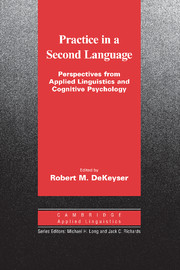Book contents
- Frontmatter
- Contents
- List of contributors
- Series editors' preface
- Introduction: Situating the concept of practice
- I: FOUNDATIONS
- II: INSTITUTIONAL CONTEXTS
- Chapter 5 A cognitive approach to improving immersion students' oral language abilities: The Awareness-Practice-Feedback sequence
- Chapter 6 Second language education: Practice in perfect learning conditions?
- Chapter 7 Meaningful L2 practice in foreign language classrooms: A cognitive-interactionist SLA perspective
- Chapter 8 Study abroad as foreign language practice
- III: INDIVIDUAL DIFFERENCES
- Conclusion: The future of practice
- Glossary
- Index
- References
Chapter 7 - Meaningful L2 practice in foreign language classrooms: A cognitive-interactionist SLA perspective
Published online by Cambridge University Press: 27 January 2010
- Frontmatter
- Contents
- List of contributors
- Series editors' preface
- Introduction: Situating the concept of practice
- I: FOUNDATIONS
- II: INSTITUTIONAL CONTEXTS
- Chapter 5 A cognitive approach to improving immersion students' oral language abilities: The Awareness-Practice-Feedback sequence
- Chapter 6 Second language education: Practice in perfect learning conditions?
- Chapter 7 Meaningful L2 practice in foreign language classrooms: A cognitive-interactionist SLA perspective
- Chapter 8 Study abroad as foreign language practice
- III: INDIVIDUAL DIFFERENCES
- Conclusion: The future of practice
- Glossary
- Index
- References
Summary
For many years now classroom-based SLA researchers have concerned themselves with how L2 practice contributes to L2 learning. In doing so they have produced a rich body of empirical evidence suggestive of certain qualities in practice that inherently call for the engagement of L2 competence-expanding processes within instructed contexts. The approach to L2 practice that this chapter presents rests on a number of cognitive-interactionist SLA theories that view language learning as arising from the interaction of multiple influences which are both learner-internal (e.g., attention to form) and learner-external (e.g., a task design that offers essential L2 input and feedback). Cognitive-interactionist SLA theories are also functionalist in that they assume L2 learning processes are activated in the course of engaging in meaning-making through language and action and as a result of functional requirements of specific things done with language. I draw on the assumption that meaningful use of the L2, and particularly the meaningful productive use afforded during communicative interactional practice, drives acquisition. This assumption is empirically grounded in the interaction hypothesis literature (Gass, 1997; Long, 1996; Pica, 1994; Swain, 2002) and in related cognitive approaches to L2 task performance (Robinson, 2001; Skehan, 1998).
This chapter first outlines three principles for L2 practice design gleaned from the accumulated empirical evidence contributed by cognitive-interactionist SLA studies. I then discuss some challenges and possibilities that FL teachers may want to consider when applying these SLA-based principles in foreign language classrooms, which naturally present particular constraints and potentials as contexts for formal L2 instruction.
Information
- Type
- Chapter
- Information
- Practice in a Second LanguagePerspectives from Applied Linguistics and Cognitive Psychology, pp. 180 - 207Publisher: Cambridge University PressPrint publication year: 2007
References
Accessibility standard: Unknown
- 47
- Cited by
